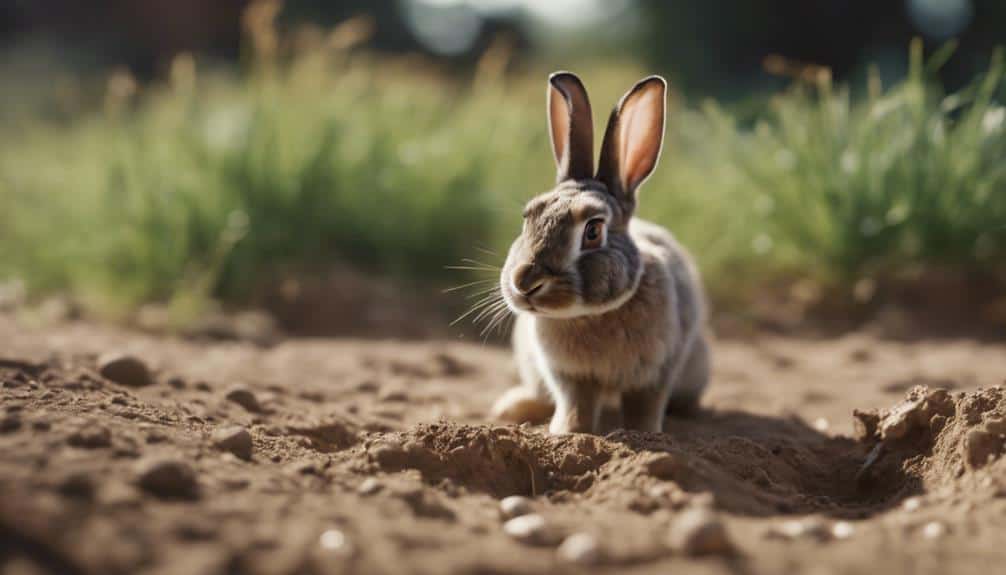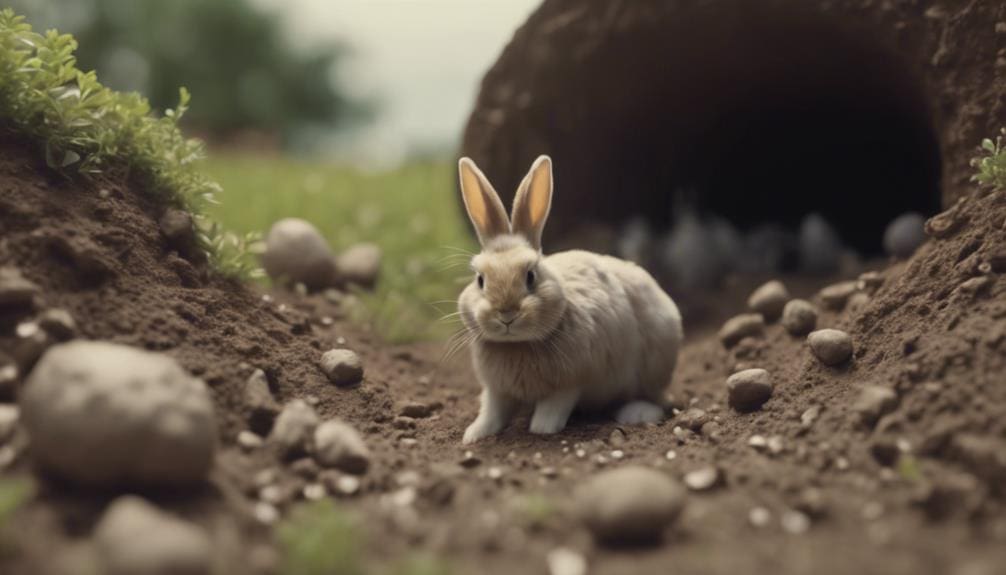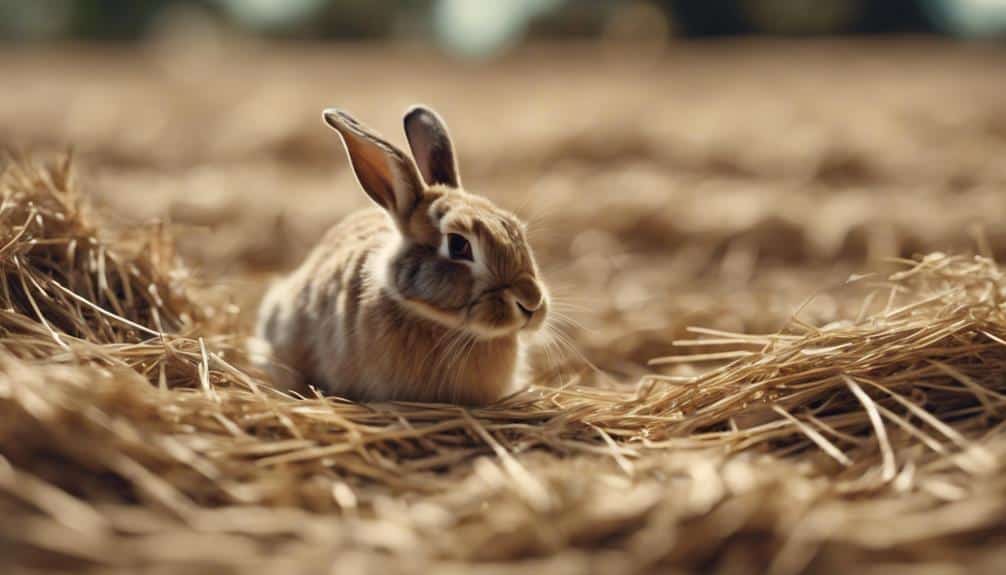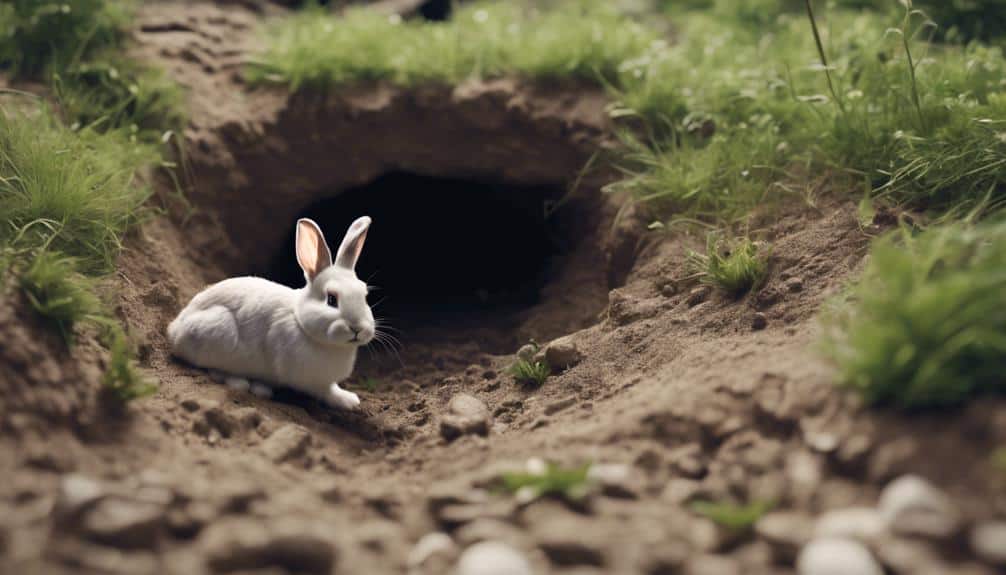So, have you ever wondered how rabbits manage to keep their burrows dry in flat land? It's a pretty impressive feat, especially considering the challenges they face with wet conditions.
One of the main things they do is design their burrows in a way that prevents water from getting in. They build their tunnels and chambers in a clever way that allows water to drain out, rather than accumulate. This is especially important in flat land, where the water table is often higher.
Rabbits also choose the perfect spot for their burrows. They look for areas with good drainage, like sandy or gravelly soil, which helps to keep their homes dry. And, they often build their burrows on a slight incline, so any water that does get in can flow out easily.
These techniques not only show how adaptable rabbits are, but also how resourceful they can be. They've developed these methods over time to ensure their underground homes remain cozy and dry, even in areas with high water tables.
Contents
Key Takeaways
So, you're wondering how rabbits keep their burrows dry in flat land. It's actually pretty clever.
First, rabbits choose well-draining soil. This helps prevent water from collecting in their burrows. They're not going to dig a burrow in a spot where water tends to pool.
Next, they elevate their burrows above ground. This doesn't mean they build them on stilts or anything, but they do create a slight mound of dirt around the entrance. This helps to redirect any rainwater that might try to flow into the burrow.
Rabbits also use waterproof materials like grass to line their burrows. This helps to keep the moisture out and the dryness in.
Another trick they use is to construct their burrow entrances on higher ground. This way, even if it rains, the water will flow away from the entrance rather than towards it.
Finally, rabbits create proper ventilation for moisture control. This means they make sure air can circulate through their burrows, which helps to evaporate any moisture that might accumulate. This keeps their burrows nice and dry.
Digging at an Angle

When rabbits dig their burrows, they're really good at digging at precise angles. This allows them to tunnel efficiently and lay out their underground homes in a strategic way.
These little creatures are meticulous diggers, using their strong hind legs and sharp claws to carve out intricate pathways beneath the earth's surface. By digging at specific angles, they can create burrows that aren't only structurally sound but also provide adequate ventilation and drainage to keep their homes dry and comfortable.
So, why do rabbits dig at precise angles? Well, it's because they want to make sure their burrows are safe and cozy. By digging at specific angles, they can create a stable structure that won't collapse. Plus, it helps them create separate areas for different activities, like sleeping, eating, and hiding from predators.
Rabbits also do something pretty interesting – they line their burrows with dried blood from predators they've encountered. This might seem weird, but it actually serves as a deterrent to other predators. The scent of dried blood signals potential danger and discourages unwanted visitors from entering their burrows.
Rabbits are also pretty picky about the plants they've around their burrows. They prefer plants that are resistant to rabbit damage, which helps prevent them from eating everything in sight. This preference helps maintain a balance between the rabbits and their natural habitat.
Lining With Dry Materials
When rabbits build their burrows, they do something really smart – they line them with dry materials.
This helps keep the temperature inside the burrow just right. In the winter, it stays warm, and in the summer, it stays cool.
Rabbits do this because they've a natural instinct to create a comfortable and functional living space.
They use natural materials to do this, which shows they're really good at taking care of themselves.
Natural Insulation Methods
Rabbits are experts when it comes to keeping their burrows cozy and dry. They line their underground homes with dry materials like straw, hay, and dry leaves. This helps to regulate moisture levels and keeps their burrows nice and warm in the winter, and cool in the summer.
They line their burrows with these materials in a clever way that helps to absorb any moisture that might be present, keeping the air nice and dry. This lining also helps to prevent moisture from building up, which is really important. Rabbits also use their own fur to line their burrows, adding an extra layer of insulation that repels water.
The design of the tunnels and chambers in their burrows is also really smart. It allows for good air circulation, which helps to remove any moisture that might be present. This prevents the burrows from getting damp and uncomfortable. Rabbits are also constantly digging and re-digging, which helps to get rid of any moisture that might've accumulated.
This keeps their burrows nice and dry, and really comfortable to live in.
Strategic Burrow Location
Rabbits know that where they build their burrows is super important. They need a spot that's going to keep them cozy and dry. To do this, they usually pick areas with soil that drains well, so they don't end up with a flooded burrow. They also like to build on higher ground or slopes, which helps them avoid getting washed out during heavy rains.
Once they've found the perfect spot, they line their burrow with dry materials like grass, fur, or leaves. This helps keep their home warm and dry by blocking out moisture. It's pretty impressive how meticulous they're when building their burrows. They carefully arrange the dry materials around the edges to prevent water from seeping in.
Creating Tunnels and Chambers

When building a rabbit warren, we use recycled drainage pipe to create tunnels that mimic a natural rabbit habitat. These tunnels are essential passageways that connect different parts of the warren. They're made from old drainage pipes, which provide structural integrity and prevent flooding within the burrow system.
One of the great things about using perforated piping is that excess water is efficiently carried away, keeping the warren dry and habitable for the rabbits. This is really important because rabbits need a safe and dry place to live.
In addition to the tunnels, we also use strategically placed nest boxes to provide secure and cozy spaces for the rabbits to rest and raise their young. We bury these boxes about 20-25 cm deep, which is the perfect depth for rabbits.
The way we position these nest boxes within the tunnel network is important because it helps to create a safe and comfortable environment for the rabbits. By combining sturdy tunnels with well-placed chambers, we can create an engineered underground habitat where rabbits can thrive.
Allowing Water to Flow Out
To keep the rabbit warren dry and comfortable, special pipes with tiny holes are used to let water drain out of the tunnels and nest boxes. This helps prevent flooding and keeps the rabbits' living spaces dry, even in areas where water tends to collect.
These pipes are super important because they allow water to flow out, preventing it from building up and making the warren damp. This careful design ensures the rabbits have a comfortable and healthy environment to live in.
| Perforated Piping for Water Drainage | ||
|---|---|---|
| Prevents flooding in the warren | ||
| Allows water to flow out | ||
| Maintains a dry environment | ||
| Guarantees comfort for the rabbits | ||
| Strategically placed for effectiveness |
Absorbing Moisture With Straw

Using straw to absorb moisture in rabbit burrows is a common practice among rabbit owners and breeders. Straw is a dried plant material made up of stems, leaves, and husks, and it has excellent moisture-absorbing properties. When you put straw inside rabbit burrows, it acts as a hygroscopic material, which means it can attract and hold onto moisture from the environment. This keeps the burrows dry and comfortable for the rabbits.
Rabbits are big on burrowing – they create intricate underground tunnels for shelter and protection. By adding straw to their burrows, rabbits can benefit from its moisture-wicking abilities. Since rabbits produce waste and sometimes bring in moisture from outside, the straw helps keep the burrow environment dry. This reduces the risk of mold growth and bacterial proliferation.
This simple yet effective method can really contribute to the overall health and well-being of the rabbits. It ensures they've a cozy and dry habitat to thrive in.
Promoting Air Circulation
When it comes to keeping rabbits healthy and happy, air circulation in their burrows is crucial.
Consider installing wire mesh around the entrance of the burrow. This allows fresh air to flow in while keeping predators out. Plus, it prevents debris from clogging the entrance, which is a big bonus.
When building or placing the burrow, think about the direction it faces. Try to position the entrance away from prevailing winds to minimize drafts inside the burrow.
Create some ventilation holes near the top of the burrow. These small holes allow stale air to escape, ensuring a constant flow of fresh air.
Consider fencing around the burrow area with a low fence. This prevents disturbances from larger animals and creates a barrier that promotes air circulation within the burrow.
Preventing Flooding Risks

When you look at rabbit warrens, you might notice how they're designed to prevent flooding.
The burrows are carefully placed on higher ground, and the rabbits have a pretty advanced drainage system in place. This helps to direct water away from their cozy little nests.
But that’s not all – the rabbits also use some clever waterproofing tricks to keep their homes safe and dry. These clever waterproofing tricks include using leaves and grasses to create a natural barrier against rain, ensuring that their burrows remain dry during heavy storms. Additionally, these rabbits often choose elevated areas for their homes, which further protects them from flooding. As a result, rabbit hiding spots in nature not only provide safety from predators but also maintain a comfortable environment for raising their young.
For instance, they use rigid plastic boxes with lids that are buried deep underground. This helps to keep the water out, even when it's pouring rain outside.
It's pretty impressive when you think about it – these little creatures have figured out how to build safe and flood-free homes all on their own!
Drainage System Design
Flooding in rabbits' burrows is a real risk, and a well-designed drainage system can literally be a lifesaver.
Flooding can be prevented and the inhabitants kept safe by considering the following factors.
By putting a layer of gravel bedding at the burrow entrance, you can help absorb water and prevent it from seeping into the burrow.
Digging trenches around the burrow can redirect excess water away from the entrance, minimizing the risk of flooding. These shallow trenches are an effective strategy.
When building the burrow, think about sloped flooring. If you construct the burrow with a slight slope, water will naturally flow outwards, keeping the interior dry.
Burrow Elevation Techniques
Rabbits are pretty smart when it comes to building their homes. They make sure their burrows are above ground level, which helps keep water from seeping in during heavy rains. This is especially important because their homes are underground, and they need to stay dry.
The way they place their burrows in tall grass is also really clever. The grass acts like a natural barrier, stopping water from flowing into the burrows. So, when it rains a lot, the burrows stay safe and dry. The tall grass even helps absorb extra moisture, which adds an extra layer of protection against flooding.
Waterproofing Strategies Employed
Rabbits have some clever ways to keep their underground homes dry and safe from flooding.
In flat areas where water tends to collect, wild rabbits have developed some remarkable adaptations to keep their burrows dry.
One of these strategies is to dig drainage channels. Rabbits are skilled diggers, and they create complex networks of tunnels with sloping floors. This helps direct water away from their living chambers, keeping them nice and dry.
Rabbits also use thick nesting materials to line their burrows. They collect dry grass, fur, and other insulating materials to create a cozy and warm space. These materials also help absorb excess moisture, which prevents flooding.
The design of the burrow entrance is also important. Rabbits build their entrances with a slight incline or a small lip, which stops rainwater from seeping inside. This simple but effective design helps keep the burrow dry and safe.
When choosing a location for their burrows, wild rabbits are very selective. They instinctively avoid low-lying areas that are prone to flooding, and instead opt for elevated spots. This helps protect their young and food from potential water damage.
Maintaining Comfortable Living Conditions
When it comes to maintaining comfortable living conditions within a rabbit warren, it's all about combining strategic design elements with the right materials to keep the temperature and dryness just right. Rabbits need a habitat that's dry, warm, and secure.
To achieve this, the warren is designed with tunnels and nest boxes built about 20-25 cm below ground level. This depth helps to stabilize the temperature inside the burrow and prevents water from seeping in. Plus, the use of stones not only keeps unwanted rodents out but also acts as a thermal mass, absorbing and releasing heat to keep the burrow cozy.
The warren also incorporates perforated piping to efficiently drain water, so flooded areas are quickly cleared and the nest boxes stay dry. To prevent mud and keep things comfortable, a weed-proof membrane covered with turf or grass is used, keeping the burrow clean and dry.
All these measures work together to create a comfortable and suitable living environment for the rabbits in their warren.
Strategies for Waterlogged Areas

In waterlogged areas of a rabbit warren, effective drainage strategies are essential to maintain ideal living conditions for the inhabitants.
Rabbits are resourceful creatures, and in waterlogged regions, they adopt specific techniques to keep their burrows dry. So, for starters, rabbits often construct their burrow entrances on slightly elevated ground to prevent water from flowing directly into their living quarters. This way, they can keep their homes dry and comfortable.
The burrow tunnels are also engineered with a slight slope to facilitate water runoff and prevent stagnation within the burrow. This simple yet effective design helps keep the water from collecting and making their living space damp.
Rabbits also incorporate ventilation shafts in their burrows to allow for air circulation, which aids in drying out damp areas. This is especially important in waterlogged regions where moisture can quickly become a problem.
To protect their young from waterlogging, rabbits build nests on elevated platforms within the burrow, keeping the kits dry and warm. This way, they can ensure their babies have a safe and healthy start in life.
These strategies showcase the adaptability and ingenuity of rabbits in creating a comfortable and dry habitat even in waterlogged environments.
Conclusion
Rabbits are really good at keeping their burrows dry, even when they live in flat areas where water can collect easily. When it rains and the ground gets soaked, they get to work, making sure their homes stay dry and comfy.
They're kind of like skilled architects, designing their burrows in a way that keeps water out. They use gravel, trenches, and sloping floors to direct water away from their homes. This way, they can create a cozy space for themselves, even when the surrounding area is damp and wet.
These clever rabbits are a great example of how animals can adapt to their environment and overcome challenges. They show us that with a bit of resilience and ingenuity, we can thrive even in tough conditions.






